White Hat Link Building Techniques
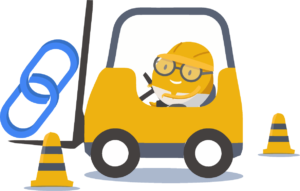
Link building has been dead for years, for those who failed to adapt to the ever-changing rules and increased requirements on skills, tools, details, and perseverance.
There has been much talking about links being a ranking factor. Many SEOs have only focused on content and On-Page SEO and neglected links saying: "We already know everything about links". But do they know everything about links?
 Google confirmed, that Links are important
Google confirmed, that Links are important
Google said links are the #1 ranking factor, alongside with great content. Ranking without links is hard, and why would anyone try to rank without links in the first place?
Google cares about links more than anything, and so should you.
Google Penguin changed the way we use Backlinks in SEO forever
Before April 2012, one could rather easily buy his ranking position by adding more and more links. A little bit of these and a little bit of those links, and you could manage ranking on the first search engine results page. Well, that time is long gone. The Google Penguin Spam Filter is now part of Google’s Core Algorithm and works in real time.
Links can possess a risk now, and you should know that risk. Did you know that even in today's world or SEO, most people still only look at the source page, the referring page, and call that "the backlink"?
A link is a connection from A to B
A hyperlink is a connection from the referring page to the target page - always has been. For way too long, SEOs have obsessed by looking at the Pagerank or whatever metric of the linking page. To our knowledge, LRT is the only software that takes the link source page and the target page into account when analyzing the value and risk of links, or even potential links.
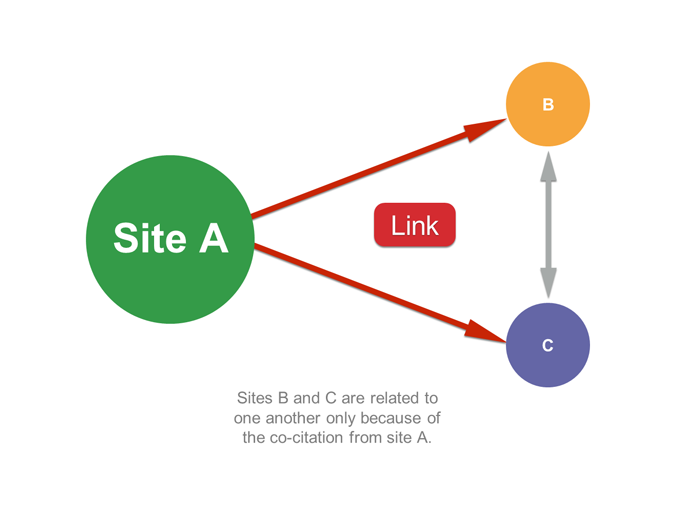
State of the Art Link Development
Today link building has grown into professional practice. Why spend tons of resources on links that would hurt you down the road? Did you know that it is possible to simulate the impact and risk of a backlink relationship before you built it? LRT users that weed the good from the chaff are happy to spend 3x more resources on the 10% great links that matter, instead of going bulk like so many.
Read on and learn more about:
- why links are the #1 ranking factor and will always be
- why links are not all the same
- bad link building vs. good link building (according to Google's Quality Guidelines)
- simple and advanced link building methods
- how to attract links with great content
- SEO tools to help you build the best links
- why link building alone is not enough to rank well
Do not let the Google Penguin algorithm intimidate you.
Start building great links today!
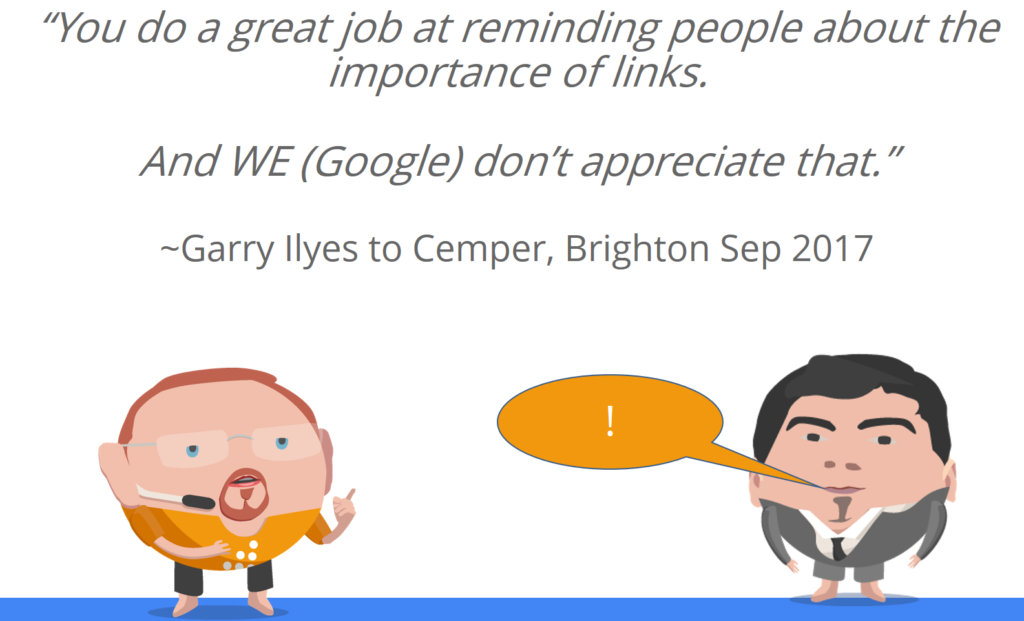
Want to learn more about link building?
What do you mean by backlink?
When we refer to a backlink we mean a reference from another web page to your own web page. This is very different from the "outbound" or outgoing links from your page. Do not confuse the two. A back link is also called an inbound link (IBL) sometimes and these links are very important in determining the popularity (or importance) of your web site for search engines like Google.
Can a website rank without back links?
We are 100% sure that a website cannot rank without inbound links.
Why is link building important?
- because links are Google's #1 ranking factor
- because links are the WEB
- because links point to great content (that deserves to rank well)
- because links pass power
- because links pass trust
- because Google confirmed that it would be unnatural to find a web site without back links
- because it's through links that Google discovers your website...
the list can go on forever...
please note (both link power and link trust are sometimes described as link equity, from an era where only one-dimensional link measurement was available)
But don't take it from us when we say that links are important, take it directly from Google.
In March 2016, in a Q&A with Google, Andrey Lipattsev, a Search Quality Senior Strategist at Google, said the first two ranking factors were links and content:
“I can tell you what they are. It is content. And it’s links pointing to your site.” (Andrey Lipattsev, Search Quality Senior Strategist at Google)
We've seen Google confirming that links are a very important ranking factorand that ranking without links is nearly impossible on other occasions as well.
A case study by Stone Temple published in 2017 proved again that links remain a powerful ranking factor and are likely to remain so for many years to come.
Are all back links the same?
"The more, the better" saying doesn’t go for links. At least not as long as "more" means links you buy without checking if they are risky for your backlink profile or not. You’d better aim for fewer high-quality links, then for thousands of links that bring no value to your backlink profile. Weak or risky backlinks won’t help your rankings at all. It can go even worst. These links can get you a Google penalty and severe (if not 100%) loss of organic traffic.
Links are not at all the same. The point is to understand:
- how many linking pages, subdomains, domains, and root domains?
- how many links per month?
- what kind of links (Follow, No Follow, Redirects, Javascript, Frames, ..)?
- what link Power and Trust?
- which linking keywords ("money" or "brand")?
- what link risk?
Also, these factors can be evaluated differently in different cases. A link can also be good or bad depending on the industry, the country, the language and the keywords. Unfortunately, there is no generic rule. For example, it is NOT the same whether a domain links to 1,000 subpages, or whether 1,000 domains link to a subpage. That's why we always recommend using the Site-Wide filter in LinkResearchTools.
What are Google's rules when it comes to link building?
Because not all links are equal, you need to be very careful when you start a link building campaign. Build links for your business, for your customers, make them relevant and associate them with great content. Your users will be happy, Google will keep you in the search results and your business will grow.
Make sure that the links you build are natural and that Google doesn't conclude that you're trying to manipulate its search algorithm.
Any links intended to manipulate PageRank or a site's ranking in Google search results may be considered part of a link scheme and a violation of Google’s Webmaster Guidelines. This includes any behavior that manipulates links to your site or outgoing links from your site.
We explain Google's Quality Guidelines regarding link schemes, to give you a clear picture of how to build high-quality links and how to stay away from building bad links. It’s all about quality, relevancy, and user focus.
Bad Link Building
vs.
Good Link Building

Simple link building tips
Although proper link building is not an easy thing to do, there are still many white hat SEO techniques you can start with even today, without considerable efforts or expenses.
1. Ask for backlinks
This is a good way to start, especially if you are a beginner in this job. Think about your friends, relatives, colleagues, partners, clients that have a blog or a site. All you have to do is ask for a backlink. Ask for in-content links instead of links in the sidebar or footer.
But be careful and make sure that the backlink comes from a website that is relevant to your niche. Otherwise, it will not have too much of an impact and may even be harmful.
2. Build relationships
For good link building, you need to build good relationships. There are plenty of opportunities to build new contacts. You should start with niche-related communities: forums, blogs or social groups, such as the Link Building Experts Group on Facebook, for example.
Make the first step and start contributing with interesting and relevant comments and posts, providing contextual value to each discussion.
By actively participating in these online communities focused on your niche, you will not only gain some good backlinks, but you will always have access to the newest industry news and be able to connect to some interesting people that share your passions.
3. Give a testimonial
Testimonial link building is a win-win scenario. Many businesses offer you the chance to say a few words about your experience using their products.
On the one hand, this is a perfect way for them to build customer trust. On the other hand, it’s a great opportunity for you to get a backlink and potential traffic from that site and it usually has a much higher approval rate than your standard link request e-mails.
Companies get another testimonial to place on their site, while you get a new backlink.
If you’re a LinkResearchTools or Link Detox user and love our tools, you can start with your first testimonial here. We will gladly link back to you.
4. Start a blog
Don’t make a blog with one post and one backlink to your site. If you do, you not only wasted your time but probably also just created another risky link for yourself. If you want to have your own blog, you need to keep it alive.
Write posts on a regular basis. Focus on your industry and on your client’s needs! In time, it will most likely gain authority. Make sure that your content is relevant, useful and well-structured.
This is the only way to ensure that the world will want to link to it again and again. That’s how you get great backlinks; you earn them!
5. List your site in trustworthy directories
There are many online directories that provide no real value to the Internet users and Google has excluded them from its search results. You don’t want your website to be listed on such pages.
But not all online directories are bad. A directory that not only gives you the chance to post a link to your website, but also provides useful information for your potential customers is a directory you want to be listed on.
Niche directories and directories attached to informative websites for a specific industry are a good choice. Having your business listed with such directories makes it easier to get indexed in the major search engines and helps people find you online.
6. Write a good guest post
There are many sites and blogs that will accept to publish your article. Before you write an article somewhere, make sure that:
- the website or blog is relevant to your topic;
- the article is NOT about how great you are/ your company is;
- you have a focus on quality (well written, professional, and interesting);
- you keep in mind that a poor article can bring bad reputation.
It’s important that you build links that help your website and not links that can negatively impact your website’s ranking in search results.
LinkResearchTools helps you quickly evaluate the Power and Trust of a domain. You can either use the Link Research SEO Toolbar to check the LRT Power*Trust of a page or domain or you can use the LinkResearchTools Toolkit to evaluate more link building opportunities at once.
Do you want more SEO resources and training?
Advanced link building tips
Link building has become a very hard and tricky job, and because of that you need professional tools to help you with that. LinkResearchTools developed 26 different tools that you can and should use for discovering and building new, high-quality links.
7. Discover competitors' common backlinks
If you research your competitors, you will probably notice that they have some backlinks in common which you don’t have yet. Well, if they managed to get these backlinks, why shouldn’t you too?
All you have to do is analyze these backlinks and try to get them as well. The Common Backlinks Tool (CBLT) is a tool made for this.
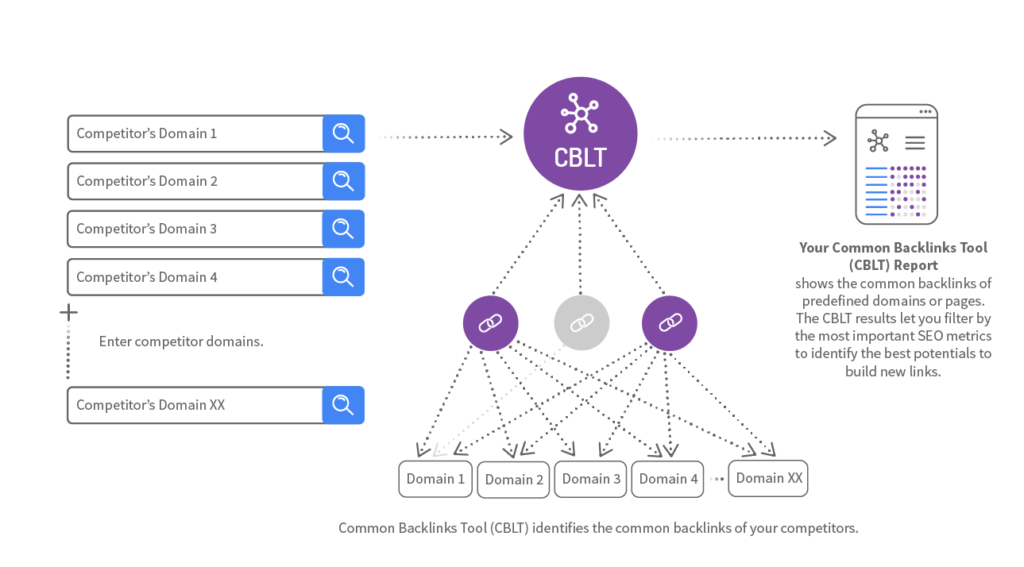
Enter up to 10 competitors and start your report. CBLT will help you not only find common backlinks, but also discover competitor’s sources and techniques.
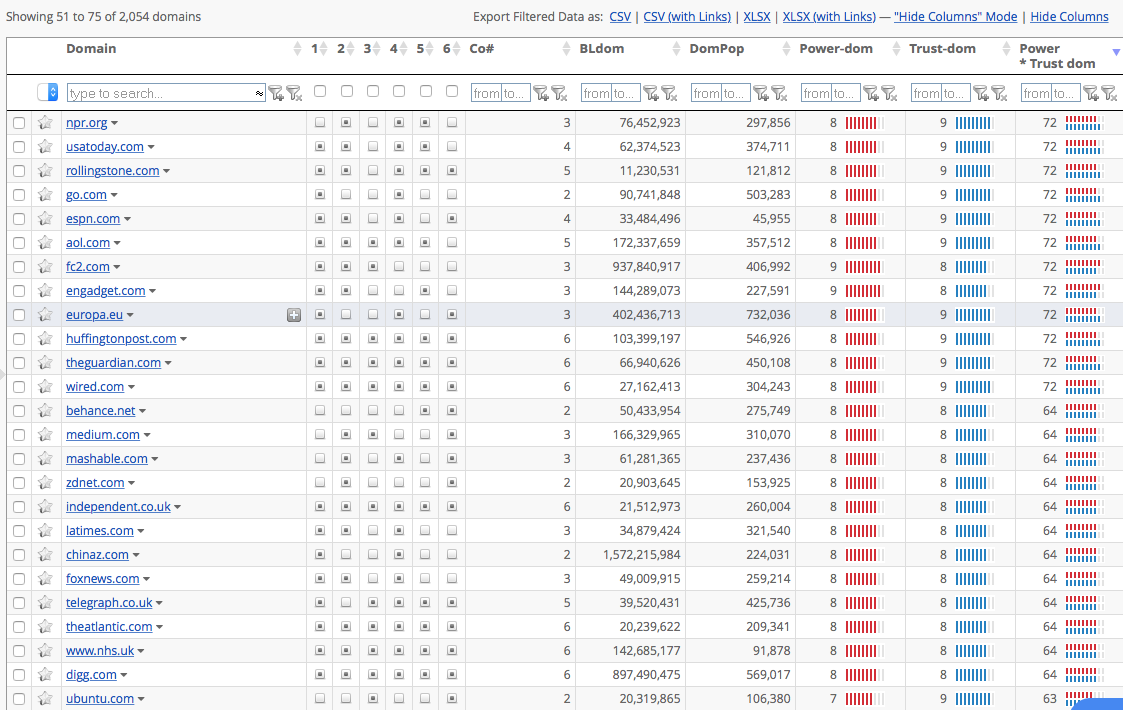
- Common backlinks for the top 6 UK newspapers, sorted by LRT Power*Trust dom
8. Get an indirect backlink from your competitor
It is quite common that some of your competitors link to the same sites. Link Juice Thief (LJT) finds places where your competitors commonly link to. These sites are usually big authorities in your industry.
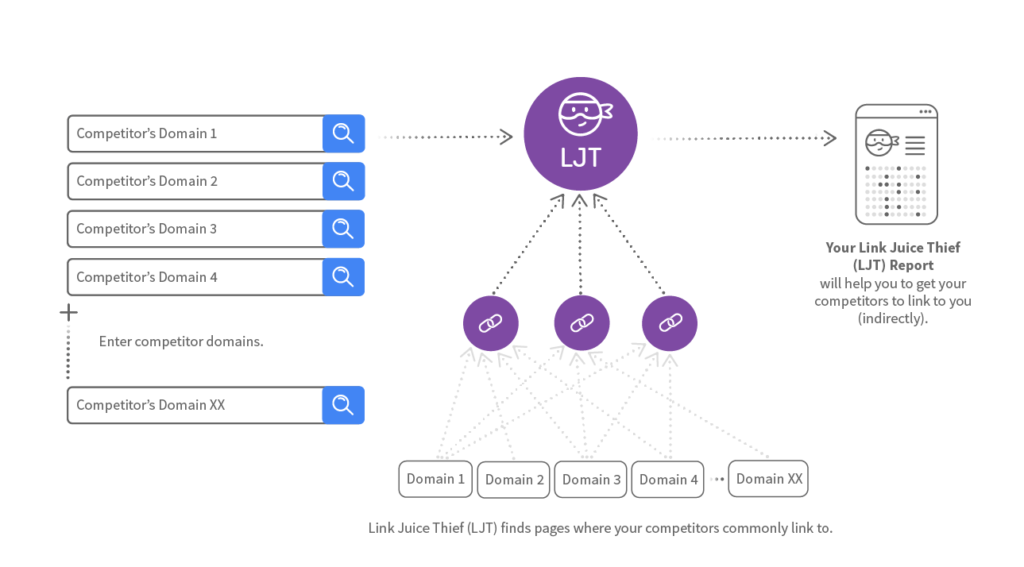
The Link Juice Thief (LJT) has a similar results matrix to the Common Backlinks Tool (CBLT). In many cases, you will find that the pages your competitors link to are authoritative sites in your niche.
A link from such a place would be very helpful as to the powerful link juice your website would receive. But there is something else: if you manage to get your backlink here, your competitors will indirectly link to you.
The Link Juice Thief (LJT) tool helps you get backlinks from high authority pages in your niche.
What are you waiting for? Go and build those links! Just make sure that these websites are relevant to your niche, have a low risk for your backlink profile and a decent LRT Power*Trust.
9. Recover your dead backlinks
Sometimes you might find broken links to your website. This may be the case if the location of your page changes or if another webmaster misspelled your link. In both cases, these backlinks will return a 404 error.
Such issues may also commonly occur after a site was re-launched or migrated to another domain. You should then redirect these backlinks to some other page.
The Link Juice Recovery Tool (LJR) helps you find the backlinks that your site has, that are linking to a non-existent page (HTTP-code 404). You should try and recover this power and trust those links have either by recreating the page, or redirecting the link to another existing page.
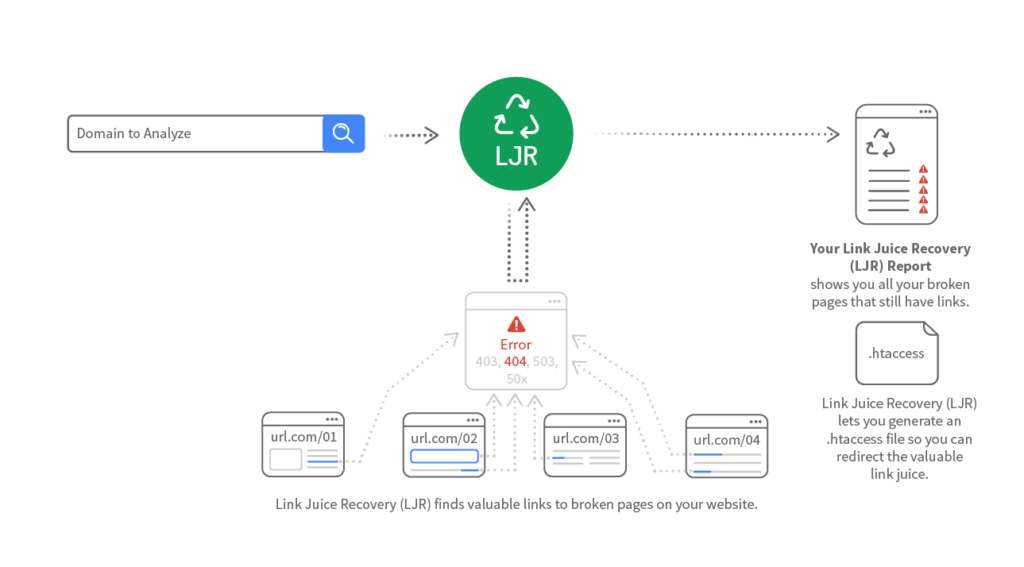
LJR doesn’t only detect HTTP-code 404 errors, it also detects timeout errors (504) or invalid access errors (403) for example. When re-launching your website, you want to look at all these errors, find the root problem and fix it before you get in trouble.
The Link Juice Recovery Tool is very simple to use; just pop in your URL there and run the report. First, you will get a list of all your broken backlinks:

Once you have the list, the LJR tool will generate a .htaccess code which you can easily insert into your .htaccess file.

Check also Wikipedia's dead links
Did you ever think about using Wikipedia's dead links as a link building source? Google finds Wikipedia to be as very trustworthy site. You can find dead or broken links there and forward or replace them. A good, free tool for this is Wikigrabber. There you can search for keywords and get the pages that require a citation on Wikipedia or have a dead link on them.
Even if the Wikipedia links are No Follow links, they still pass on a lot of trust. Don't think that Google doesn't look at No Follow links. It does since we've also seen them mentioning No Follow links in Manual Action penalty claims.
You can learn more about No Follow links and their positive or negative impact of No Follow Links on organic search rankings in the research and market survey we published.
Do you want more SEO resources and training?
10. Turn your mentions into backlinks
This is probably one of the easiest ways to gain some new backlinks. Somebody already wrote something about you. They mentioned your brand or product, but they have not linked to your website. In situations like these, it is usually enough to contact the webmaster and ask him to convert that mention into a backlink.
But, how do you find those mentions? With LinkResearchTools is easy. All you need to do is start a Backlink Profiler (BLP) report and filter the results by Link Status > MENTION.

Backlink Profiler (BLP) - Mentions
The Backlink Profiler (BLP) is a great tool for finding mentions that look like links but to find brand mentions that don’t look like URLs will take a little more digging.
Another way to find and monitor mentions is by using the SERP Research Tool (SERP) with a smart combination of advanced search operators.
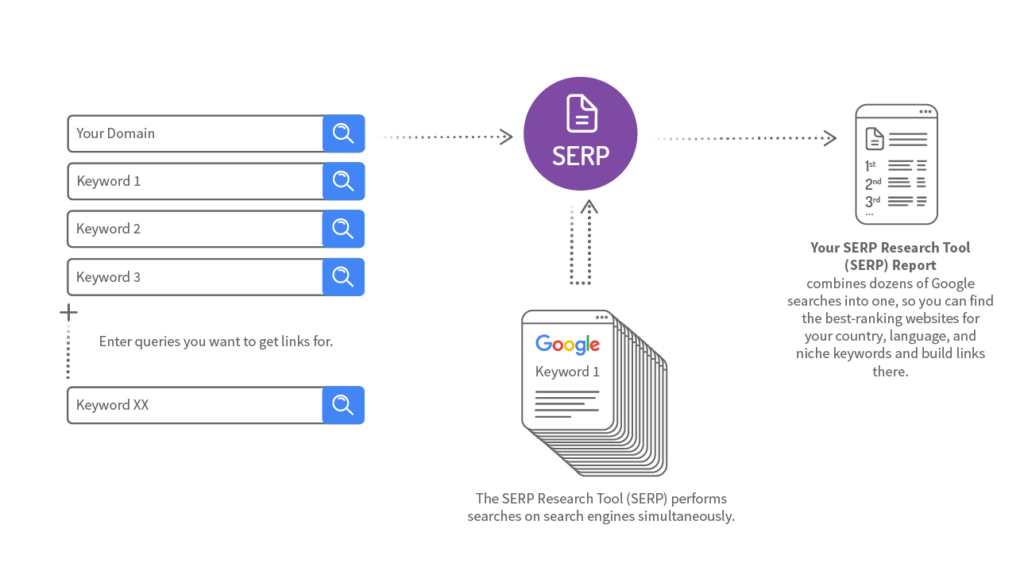
Here’s an example where we try to find mentions of Active Campaign, with no link to www.activecampaign.com, using the SERP Tool from the LinkResearchTools SEO toolkit.
Here are the search operators we used in this example:
- “active campaign” OR “activecampaign” -activecampaign.com
- “active campaign” “marketing automation” -activecampaign.com
- “active campaign” “email marketing” -activecampaign.com
To find the most mentions you should select all results from any time or the last year. It’s best to use the local search engine and language that your target audience will use too. In the metrics section, you can select the metrics you wish, but you will want to look at the LRT Trust*Power Details.
Once your SERP report is completed, you need to select “NO” in the ‘Linked’ column to see the URLs that are not linked to your site.
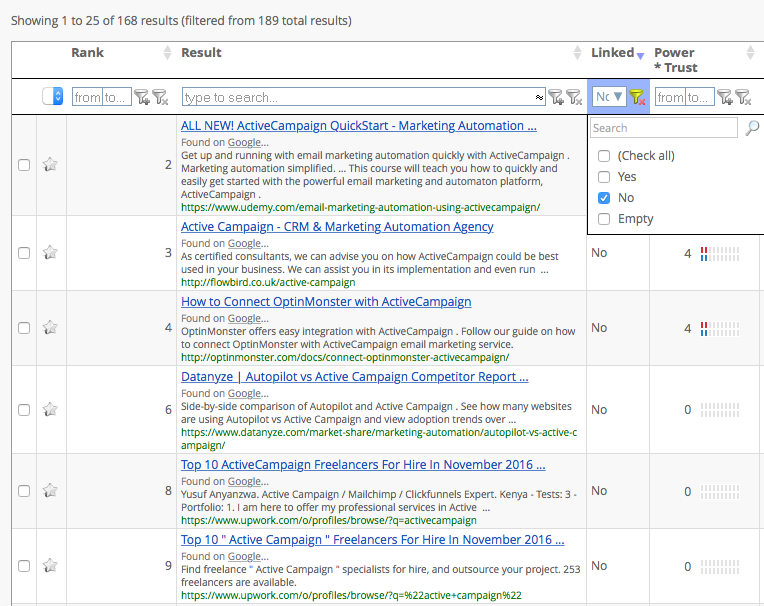
ActiveCampaign Mentions - SERP Tool
To find the strongest pages mentioning your brand, you can sort the results further by LRT Power*Trust.
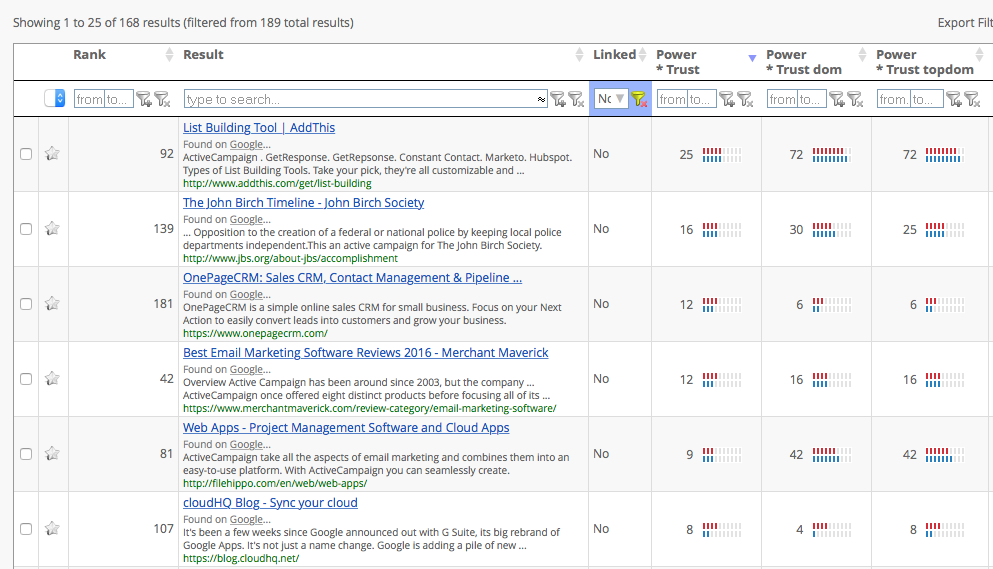
High LRT Power*Trust ActiveCampaign Mentions - SERP Tool
If someone already mentioned your brand, then why wouldn’t they want to link to you?
A simple email like this will usually do the trick:
“Hey [NAME],
I'm [YOUR NAME], [POSITION] at [WEBSITE].
I see you mentioned my [WEBSITE] on [Your Page] about [The Subject]. Thank you for doing that I really appreciate it.
However, I was wondering if you would mind adding a hyperlink, so that people can find out more about [The Subject].
I think it would be super-useful for your visitors.
Looking forward to hearing your thoughts on this.
Thanks a lot.
All the best.
[Your Name]”
The SERP Tool might not find as many mentions as a straight Google search. However, it will find the most relevant results, so you can avoid wasting time chasing links that may be weak or irrelevant.
11. Find the strongest competitors healthy backlinks
Since Google launched the Penguin update in 2012, strong links are not the only webmaster's concern. If you do not want to be penalized, links must be safe as well. How do you find those strong, and yet not risky links, relevant for your niche?
You can use Competitive Link Detox (CDTOX) to compare your site against 10 of your competitors.
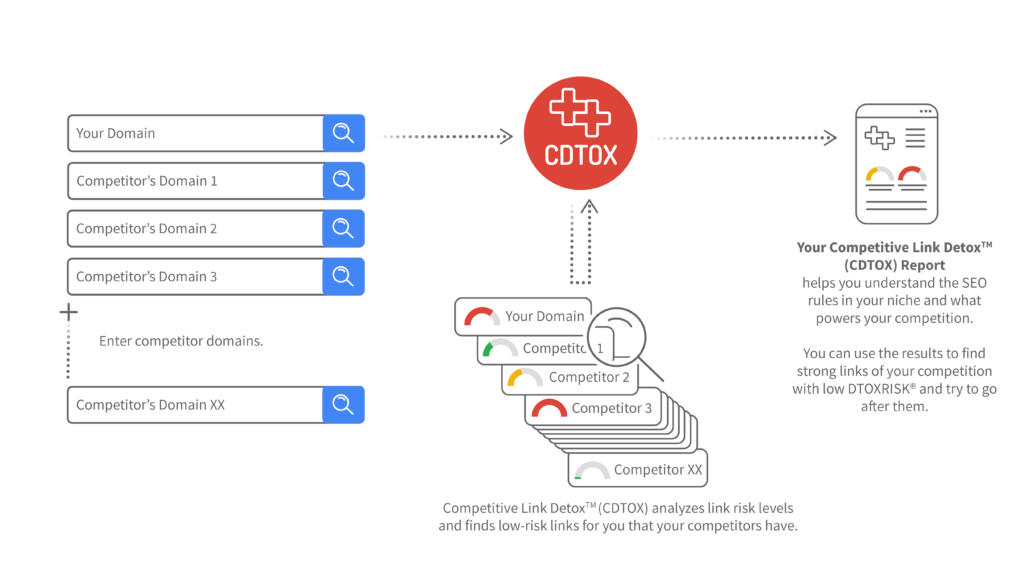
After you get the report results, you can easily sort links by LRT Power*Trustand by very low DTOXRISK.
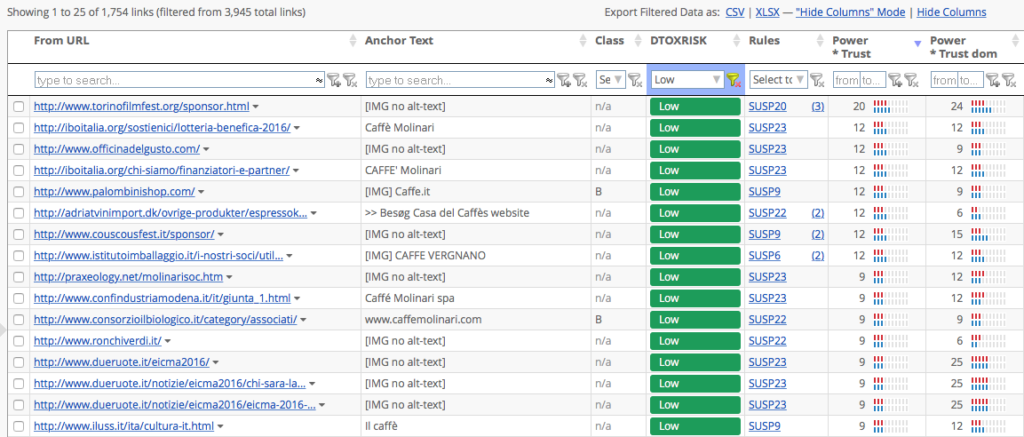
Italian Coffee Sellers Competitor's Links With Low DTOXRISK and High LRT Power*Trust
12. Find the most relevant link building opportunities
There are many opportunities for link building on the Internet. There are many forums, blogs or sites where you could place your backlink, but usually, it is not so easy to find them. Whether you want to find a strong relevant site or blog where you can place a guest article or thematic forum with Follow links – the SERP Research Tool will help you. SERP is designed to help you find the most relevant and strongest results.
After you get your results, you can sort them by strength, theme or any other metric you want. The best thing about SERP is that you know these links are relevant and high authorities in your industry.
Here's an example of how to use the SERP tool to find great guest post opportunities for the bodybuilding and fitness industry.
Search operators:
- inurl:submission-guidelines + muscle building,
- inurl:write-for-us + workout routines
- workout +guestpost +health
- contribute +fat loss
If you sort the SERP tool results by LRT Power*Trust, you will discover some great guest posting opportunities.
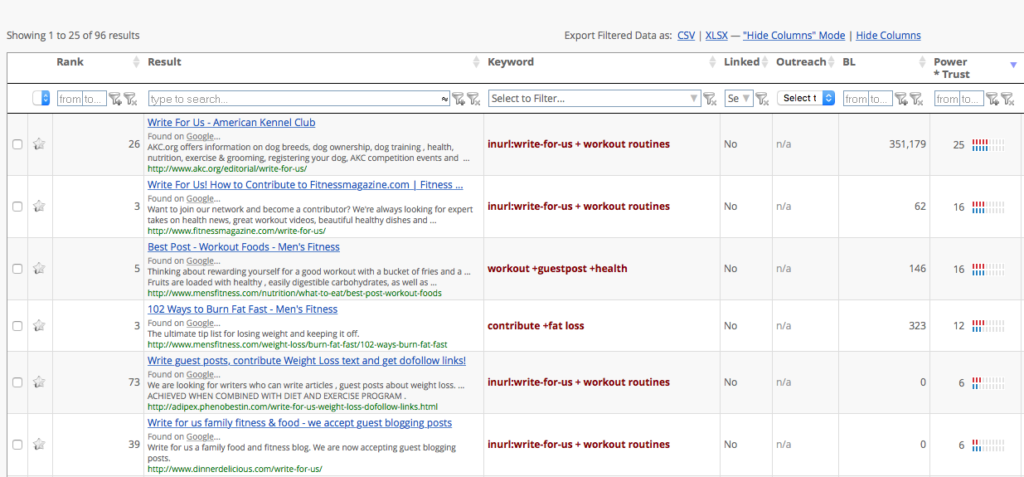
SERP Tool Guest Post Opportunities Sorted by LRT Power*Trust
13. Be aware of your competitor's new links
Very often, a quick reaction can mean the difference between success and failure. On the Internet, it is pretty similar. It is extremely important to be aware of your competitor's activities.
Link Alerts (LA) is a tool made to inform you about your new backlinks, but, apart from that, you can also use it to monitor your competitors.
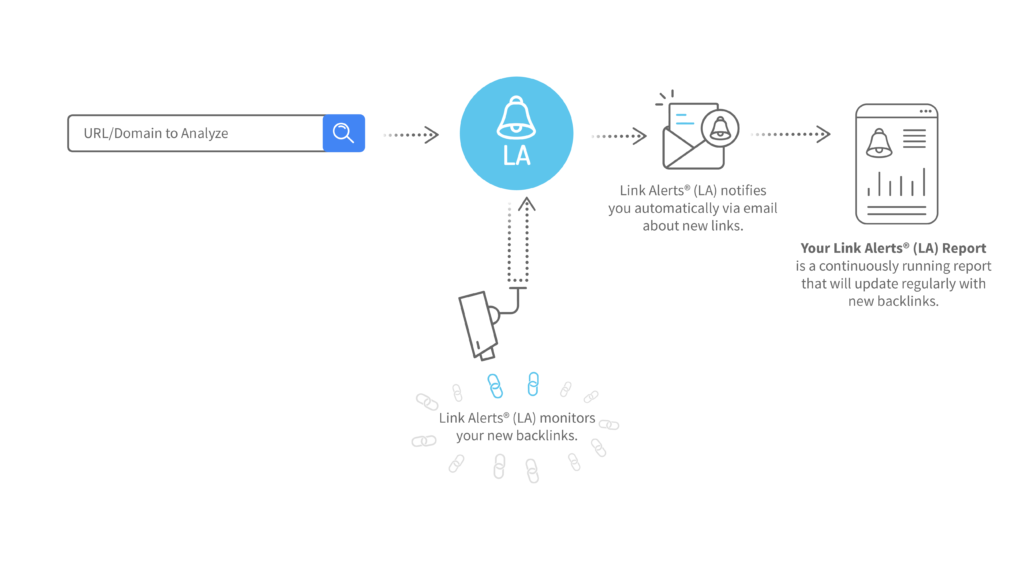
Not only will it help you find some new backlink opportunities, but it can also enable you to discover some new sources and techniques you could use in the future.

The best thing about Link Alerts is that you can set it up to send you e-mail notifications with fresh backlinks. It's like Google Alerts, but for links. This will allow you to identify negative SEO attacks right away. In case of new, unwanted links, you can react immediately, and thus protect your site from being hit by a Google Penalty. Read all about the risks and techniques of negative SEO attacks here and learn how you can protect your site.
14. Launch a "Scholarship" contest or a giveaway campaign
.gov and .edu links pass a lot of Trust, but they are also very hard to get. Here's a great example of how The HOTH does it.
They launched "The HOTH SEO Scholarship Program" awarding a scholarship to students in the United States who write a blog post on the topic “How Companies Can Take Advantage of Digital Marketing”. The requirements are simple:
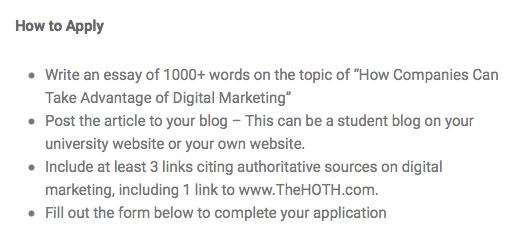
Students have access to University Blogs and magazines. I bet that The HOTH will get a lot of high-trust links from this campaign. After a quick peek at their backlink profile, I see that they already earned a lot of .edu links from the "Scholarship" campaign. A very smart link building idea if you can afford it.
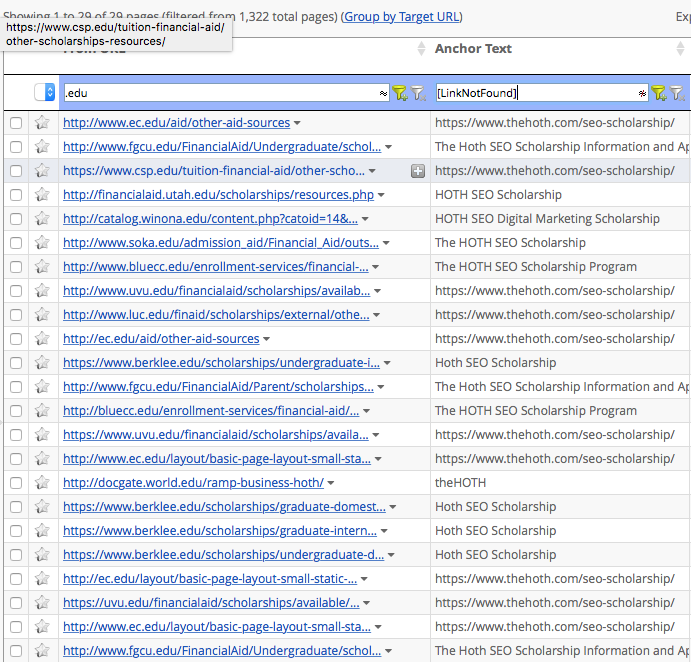
The HOTH Backlink Profile .edu Links
Link Earning Tips - earn your links!
Building links is one thing, but you can also earn links if you put out great content.
Google's primary goal is, just like for any other company, to earn money. And Google cannot earn anything unless they provide good user experience. And good user experience, in turn, comes with good and relevant search results. If they fail to show relevant results, users might switch to some other search engine.
What does great content mean for Google?
Great content is:
- desirable
- findable
- useful
- accessible
- credible
- valuable
Google checks technical features of your site like site load speed, navigation, design, keyword density, complexity, etc. Also, they will measure user experience through Click-through Rate (CTR), bounce rate or time spent on the site.
But, there is something more; one really simple fact: Good content will bring you a lot of natural backlinks! ...and Google looks at links as well. In fact, links are Google's #1 ranking factor.
Hower, if nobody sees your great content in the first place, there are no links growing. This is where link outreach comes in.
“How to write a high-quality article” would be another interesting topic, but for now, let's focus on how you can earn more backlinks with your content.
Do you want more SEO resources and training?
15. Infographics
However good your writing, some people find it easier to grasp information visually.
Different people grasp information differently, and your business message has to be available in every form so that it can capture the attention of a wider audience.
Many people use Infographics to attract links. And it works. Sometimes someone might use your infographic, but without linking to you. In such case, you could start a “Google reverse image search”.
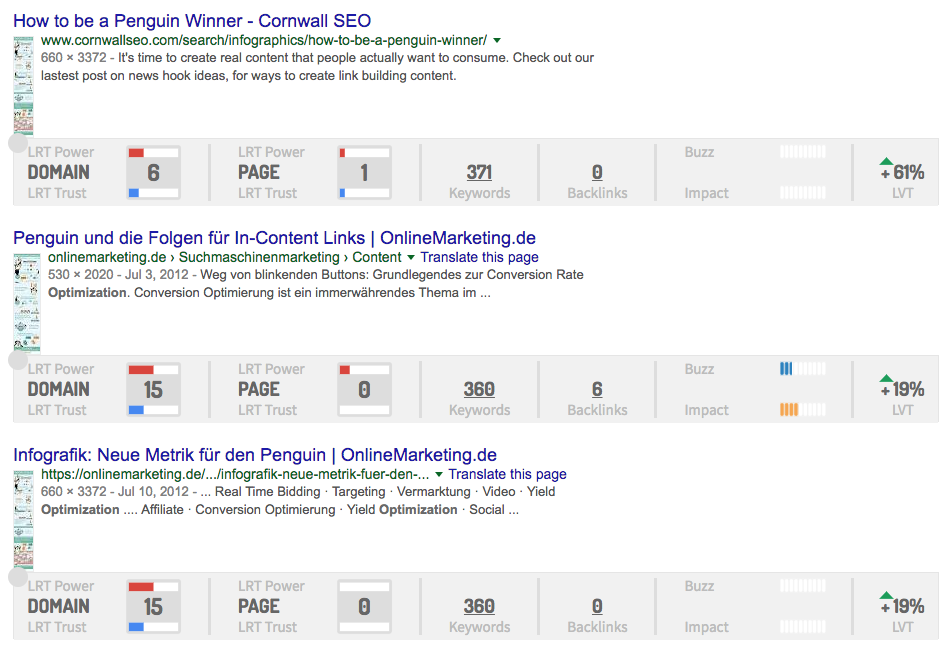
- Google Image Search for Infographic
If you notice that a webmaster “forgot” to link you, you could simply warn him to do so.
16. Lists
You know what?
- Lists
- Are
- Cool
It’s psychological; our brains love lists. If you create some cool list, there is a big chance that people will click on it and later share it. Just compare these two headlines:
"Green tea is good for your health"
"7 incredible reasons why you should drink green tea"
"7 incredible reasons why you should drink green tea"
Let's be honest, even if you do not like green tea, you will click on the second headline.
17. Research reports and case studies
Your personal opinion can be interesting and valuable, especially if you have been in a specific field for a long time. But, if you want to become an authority and earn a lot of backlinks, you will have to show facts and stats. That’s the reason why the most sharable contents are:
- Research papers
- Case studies
- Reviews
- Comparisons
Try to be the first to write about a certain topic. Fresh content is critical in any industry especially if your niche changes quickly. In your research, include all relevant data, test results, charts and always link your sources.
18. Newsletter subscriptions
Usually, companies do not understand the importance of a newsletter. If it is used properly, the benefits can be great. Publishing a newsletter will increase attention and awareness of your readers or clients. With quality and interesting content, you increase the probability of sharing it, thereby increasing traffic and the number of backlinks.
Try to include some effective call-to action button in your newsletter, for example offer them to register for some webinar, download some whiter paper or eBook.
19. Extra material
You can also try and get the most value from every piece of content you create by reusing your content in different formats:
- guides
- infographics
- videos
- webinar recordings
- transcripts
- podcasts from research
There’s plenty of room for creativity when it comes to marketing.
By using multiple content formats, you will generate more leads and move them further. Also, you will show expertise and increase your authority.
20. Learn from others
There is nothing as sad as people who spend days and weeks writing about something and then… nothing. All that passion and knowledge for nothing. Good, and yet unnoticed articles are something that happens every day and to everybody.
The problems can be various. Usually, people make a mistake with the choice of the topic. It doesn't matter how good your article is if nobody cares about that topic. The opposite can happen too; cool topic, but weak content!
You can read hundreds of articles and watch dozens of videos about good content, but there is always one safe road: learn from others.
For example, you want to write about health, but don't know which topics are the most popular? Well, let's start one simple report with the Strongest Subpages Tool (SSPT).
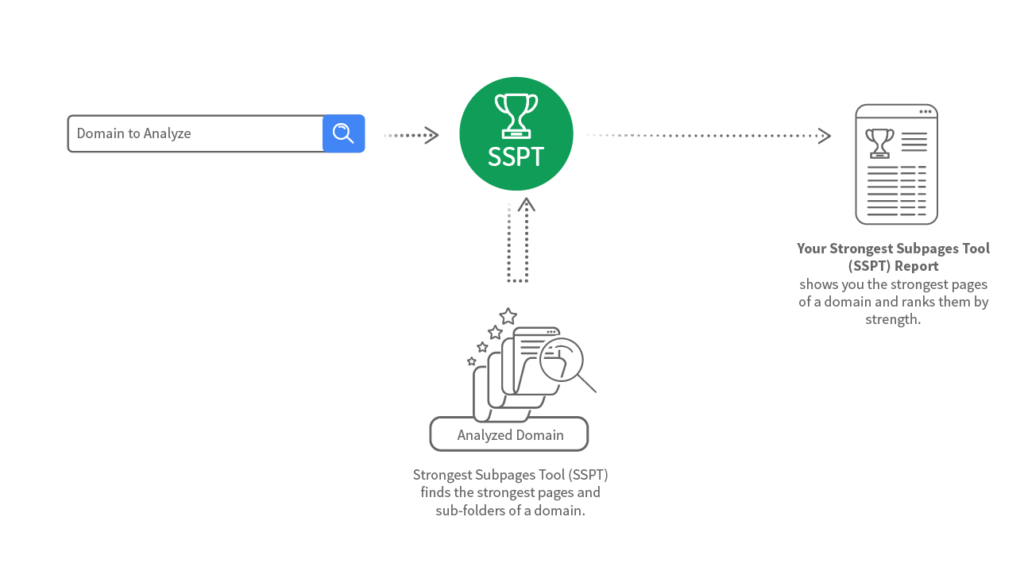
We tested on thehealthcareblog.com. Here is a list of the blog posts, sorted by LRT Power*Trust.
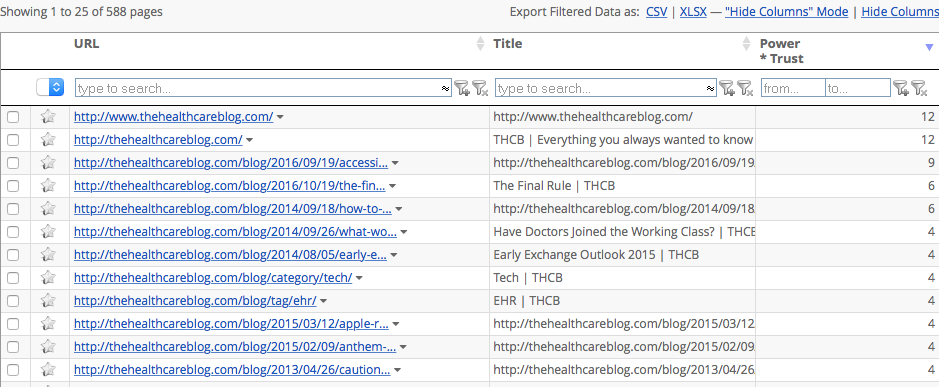
If you really want to see, how many backlinks these blog posts received, you only need to analyze these pages in the Bulk URL Analyzer (Juice Tool).
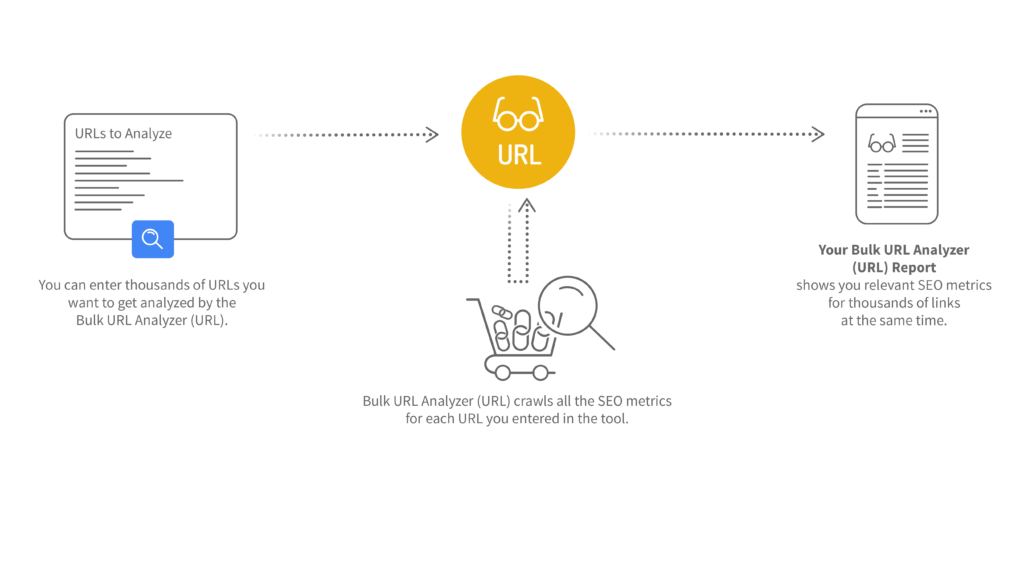
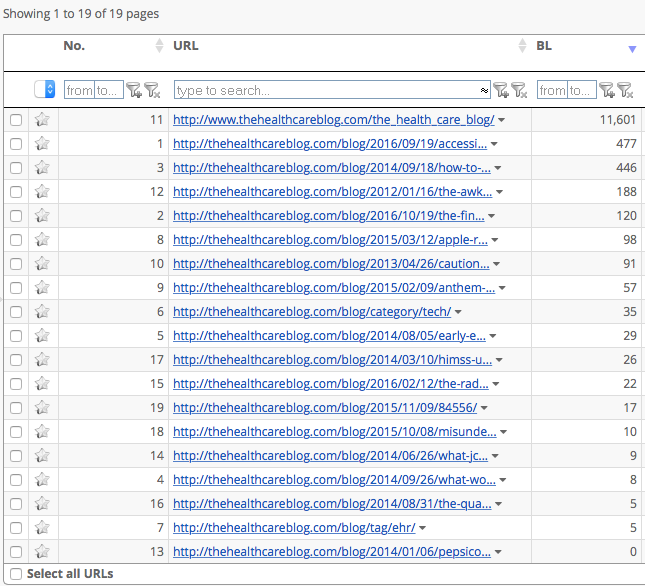
- Bulk URL Analyzer (Juice Tool) - Pages sorted by number of backlinks
Link Building Tools
Here's a list of all the tools we used to create this article:
- Common Backlinks Tool (CBLT)
- Link Juice Thief (LJT)
- Backlink Profiler (BLP)
- Link Juice Recovery Tool (LJR)
- Bulk URL Analyzer (Juice Tool)
- SERP Research Tool (SERP)
- Link Alerts (LA)
- Strongest Subpages Tool (SSPT)
We encourage you to start building links. But before you do that, make sure to do a detailed link audit, and disavow all the spammy links you bought in the past and use Link Detox Boost to make Google crawl the links in your disavow file faster. Disavow all the links that have a high risk. You don't want Google Penguin to find them, do you?
Remember that Google Penguin is now part of Google's core algorithm, so it runs in real time. You can get a penalty with every re-crawl.
BONUS TOOL TIP: The Link Opportunities Review Tool (LORT) allows you to check links quickly and easily. With LORT, you can quickly decide which links are good for your website and avoid building risky links.
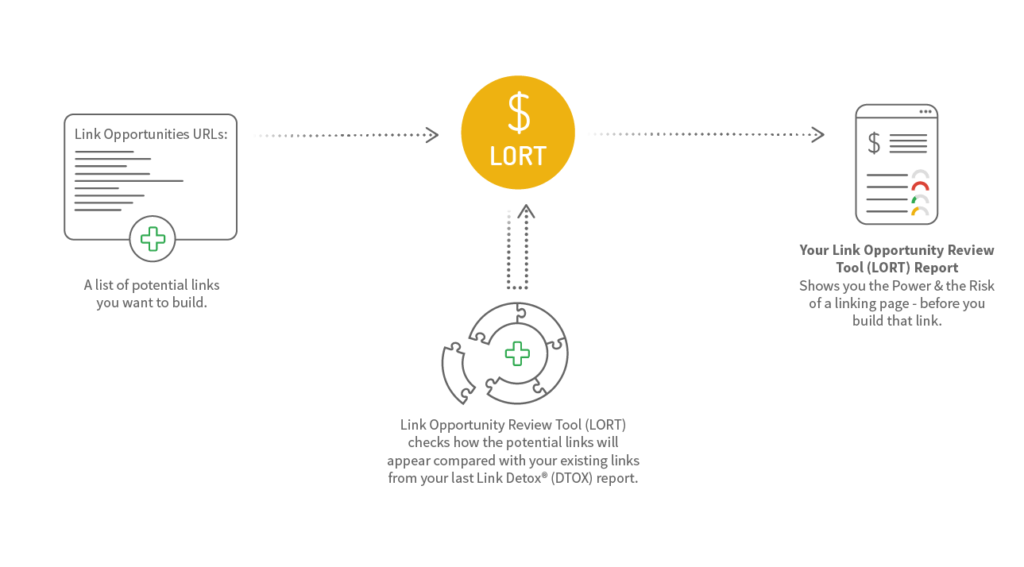
Link Building is not enough
If you want your website to rank well and stay penalty-free, building new links is not enough. You need to take care of your backlink profile and disavow all the spammy links.
In November 2017, Google's John Mueller confirmed that doing proactive disavows is a good idea if you want to prevent a Google penalty.
So in particular if someone is pasting links on a spammy site, or maybe a previous SEO went off and ran some script to place links and a bunch of forums, and you can't clean that up for whatever reason, and you don't have a manual action, but you want to make sure it doesn't even get that far, then the disavow file is a great way to just like preemptively say well I know about these issues, I don't want to lose any sleep over them, I'm just going to disavow them and get them taken out of the equation.
John Mueller, Google Webmaster Central Hangouts (14 November 2017)
Where are all the spammy links coming from?
You can have spammy links from the past. Maybe you bought some, or maybe your SEO didn’t care too much about the quality of the links he built for you.
The truth is that you can get bad links every day. Your competitors don’t want your website to rank well. They can plan a negative SEO attack, sending a lot of spammy links to your website.
That’s a very good reason to check your backlink profile regularly using Link Detox.
Monitor your backlink profile and do proactive disavows
If you want to stay competitive, you need to protect your website for the future. Put SEO on your long-term agenda and monitor your backlink profile regularly.
We know this does not sound like a walk in the park, but luckily there are automatic tools like Link Alerts that can help you stay on track. Using this tool, you will be notified when new backlinks appear. This allows you to react quickly in case of unwanted new backlinks, and thus avoid common SEO techniques like negative SEO attacks.
source http://tessrijogo.blogspot.com/2019/11/20-seo-link-building-tips-for-2019.html


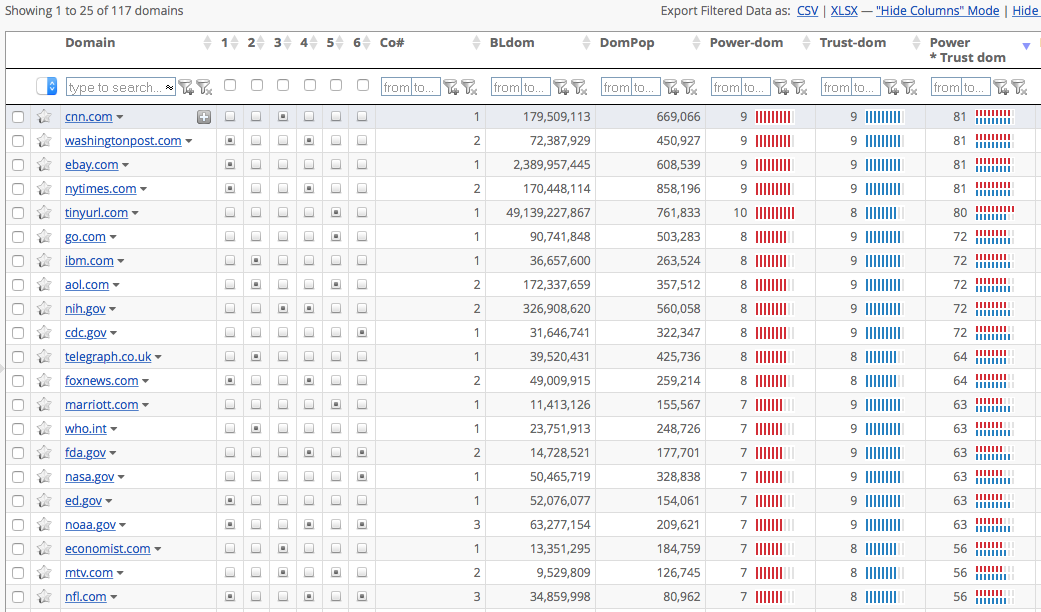
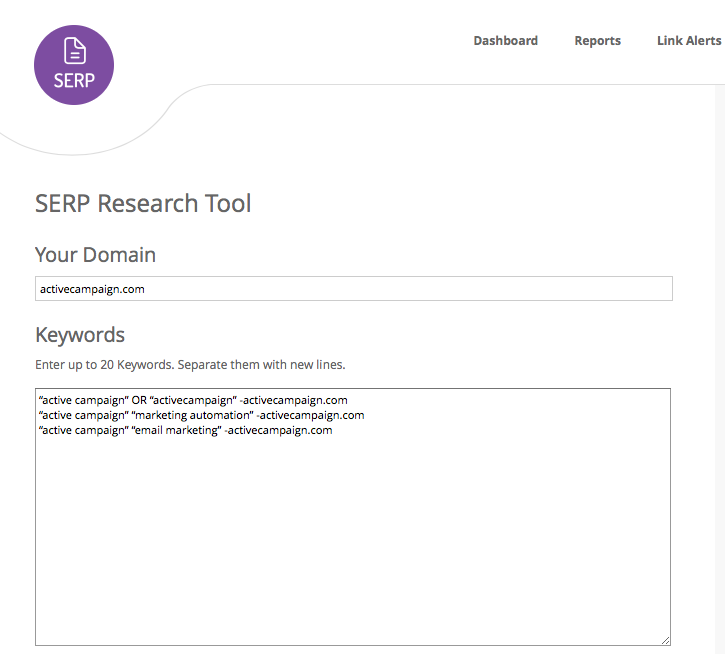
Комментариев нет:
Отправить комментарий